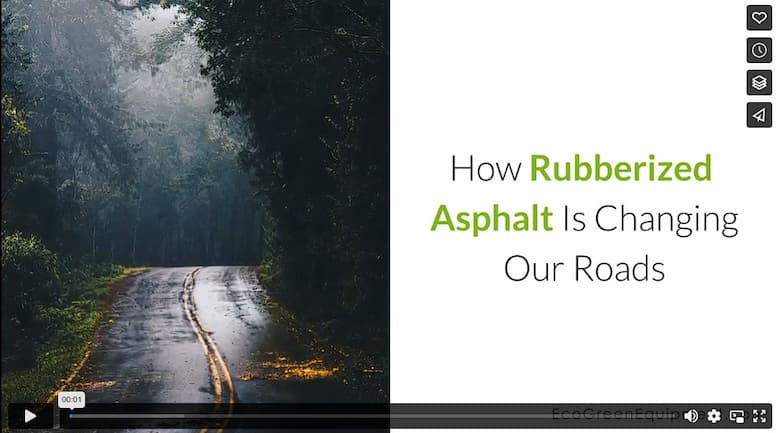The National Highway System is a network of 160,000 miles of paved highways and over 128,000 overpasses, bridges, and other structures. We all drive miles of these paved roadways each year. Unfortunately, many of these roads were originally paved in the 1960s and ’70s. Because of the limited lifetime of asphalt paving, many of these roads need repair or replacement.
While many of the materials used in this infrastructure can be recycled and used in these upgrade projects, other materials are needed as well. Fortunately, many of these added materials can be repurposed from other products, allowing for a smaller environmental footprint. One of these materials, known as rubberized asphalt, is becoming particularly popular for its ability to build stronger, longer-lasting roads for the future.
What is rubberized asphalt?
Rubberized asphalt is a paving material made from crumb rubber. It is a binder and an aggregate. Twelve million tires per year become crumb rubber for use in rubberized asphalt. It is the largest market for crumb rubber in the United States.
This crumb rubber is produced at waste tire recycling plants. The tires are initially cut into smaller pieces by a primary shredder to prepare them for further processing, and the steel wire and fibers are separated from the rubber. With these other products removed, the rubber can be further broken down in one of two ways.
Ambient grinding uses the mechanical forces in tire shredders and granulators to break the rubber down into smaller and smaller pieces. Alternatively, the rubber can be frozen in liquid nitrogen and shattered into crumbs in a process known as cryogenic fracturing. Ambient grinding is preferable when making rubberized asphalt. It results in crumbs with a rough outer texture. The more surface area the crumbs have, the more quickly they react with the binders in the asphalt mixture.
How did recycled rubber become road material?
In the 1960s, a materials engineer in Phoenix, Arizona named Charles McDonald worked on developing a better way to patch surface damage in the streets. He experimented with sealing cracks and filling holes using recycled tire rubber and aggregate. While some of his “recipes” worked better than others, he was determined to find a solution. When he finally figured out how to make this combination of materials work, residents were astonished at how long these patches lasted. These patches had the added benefit of cutting back on road noise as well.
In 1991, the Intermodal Surface Transportation Efficiency Act (ISTEA) set a standard for the amount of crumb rubber used in asphalt to take effect at the beginning of the 1994 paving season. However, this legislation was short-lived. The mandate was lifted just one year later, in 1995. Not all states abandoned the idea, though. Some states, such as Florida, Arizona, Rhode Island, and Texas, continued to develop and refine methods for used recycled tire rubber in their paving projects.
The state of Arizona, in particular, invested significant time and money into this idea. In 2003, the Arizona Department of Transportation (ADOT) partnered with the Federal Highway Administration (FHWA) to launch a $34 million, three-year project called the Quiet Pavement Pilot Program. The program’s goal was to investigate whether rubberized asphalt could reduce road noise enough to eliminate the need for sound barriers on major roads. After one year, the evidence was clear. Adding crumb rubber to the streets significantly decreased the noise produced by passing cars up to 12 decibels. Its ability to reduce road noise would make rubberized asphalt more appealing to other states, leading to more testing and research.
Why use rubberized asphalt instead of traditional asphalt?
Although rubberized asphalt was developed initially as a way to make road patches last longer, recent studies have shown that it comes with many more benefits.
- Noise Reduction – As noted in the study done in Arizona, cars produce less noise when driving on rubberized asphalt. The rubber creates a more porous and flexible road surface that dissipates the vehicle’s sound instead of reflecting it outwards the way hard surfaces do.
- Greater Longevity – One of the first properties of rubberized asphalt observed was that patches made from this type of material lasted much longer than previously used asphalt. More recent case studies on the topic show that it can last up to 50% longer and resists cracking.
- More Economical – Paving a road with rubberized asphalt requires less raw materials, as it can be thinner and still handle the same volume of traffic. The reduction in initial materials cost combined with a decrease in repairs makes rubberized concrete cheaper to build and maintain.
- Increased Safety – Rubberized asphalt is darker in color. Road markings stand out better against this dark road surface, making night driving easier. Studies have shown that the added crumb rubber gives drivers better traction and reduces skidding as well.
- Environmentally Beneficial – Using scrap tires to pave our roads is a responsible way to re-use the masses of rubber that would otherwise be discarded every year. Resurfacing a road with two-inch-thick rubberized asphalt uses 2,000 scrap tires per lane per mile. It doesn’t take a large project to make a measurable dent in our overly large sized problem. For example, California alone produces 40 million tires per year. 75% of those can be diverted away from landfills into this type of construction project.
Although most rubberized asphalt projects currently underway in the United States are taking place in warmer states, the practice is catching on elsewhere. States like Colorado and Washington are adopting the methods and techniques used elsewhere to see if they can overcome the challenges associated with mixing, laying, and compacting this material on their roads. It is only a matter of time before we are literally driving on tires wherever we go.
Video





